What is Gau Pooja (Cow worship), Chintana (Thinking / excogitation), Vatsa Dwadashi (Vasu Baras) | What is the significance of cow Puja?
Namaste friends, how are you doing today? Welcome to #BhagavanBhakthi website / blog.
Bhagavan Lord Sri Vishnu (Krishna, Rama, Trivikrama, Narasimha, Vamana, Vasudeva, Mukunda) and Goddess Lakshmi (Rukmini, Satyabhama, Sita, Kamala, Maya) blessings to you and your family!
In this website / blog, you will always learn about #Hinduism #Sanskrit language.
Also subscribe to my YouTube channel from this link #BhagavanBhakthi to view videos about #Hinduism #Sanskrit language.
Just before going to “What is Gau Pooja (Cow worship), Chintana (Thinking / excogitation), Vatsa Dwadashi (Vasu Baras) | What is the significance of cow Puja?“, let us have a brief some brief information.
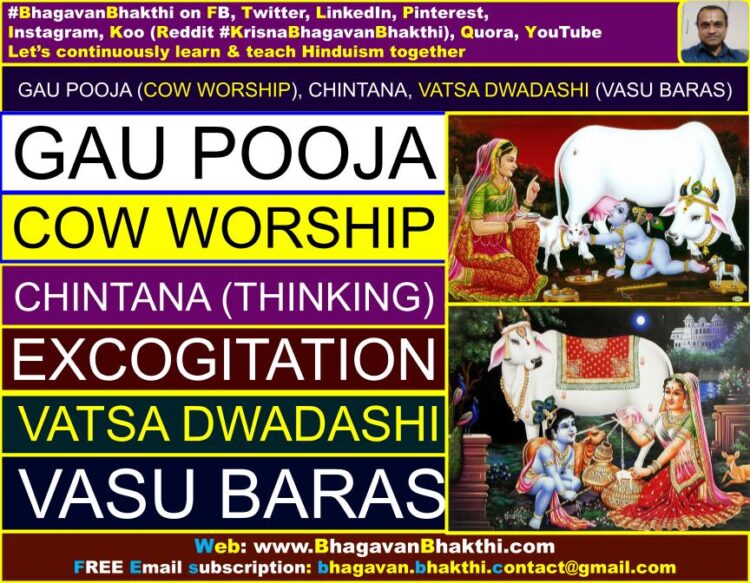
Gau means धेनु / ಧೇನು / dhenu, that is, someone who always keeps on giving and giving and giving milk without any expectations from us.
How to do Gau pooja, chintana and other significance : Gau Mata (Mother Cow) is also called as Kamadhenu, Nandini, Surabhi, Susheela, Bahula etc.
Meaning of the above names: 1. Kamadhenu (कामधेनु / ಕಾಮಧೇನು / kāmadhēnu): When we separate this name it becomes, Kama + dhenu. Here Kama means wish and dhenu means giver.
This this, Gau mata (Kamadhenu) is someone who always keeps on giving to human society and she never expects anything from us, even proper food.
Other names given to Kamadhenu is, she is someone who is called as a Sabala (spots present on her body) and Kapila (She is having red eyes).
The different identification given to Kamadhenu are “Kamaduh” (कामदुः / ಕಾಮದುಃ / kāmaduḥ) and “Kamaduha” (कामदुह / ಕಾಮದುಹ / kāmaduha), this means cow is someone from whom all the desired things can be gained.
Kamadhenu is always a giver and has zero expectations from humans. That’s why Gau mata or Kamadhenu is so divine and auspicious and yes, she is definitely ‘Great’.
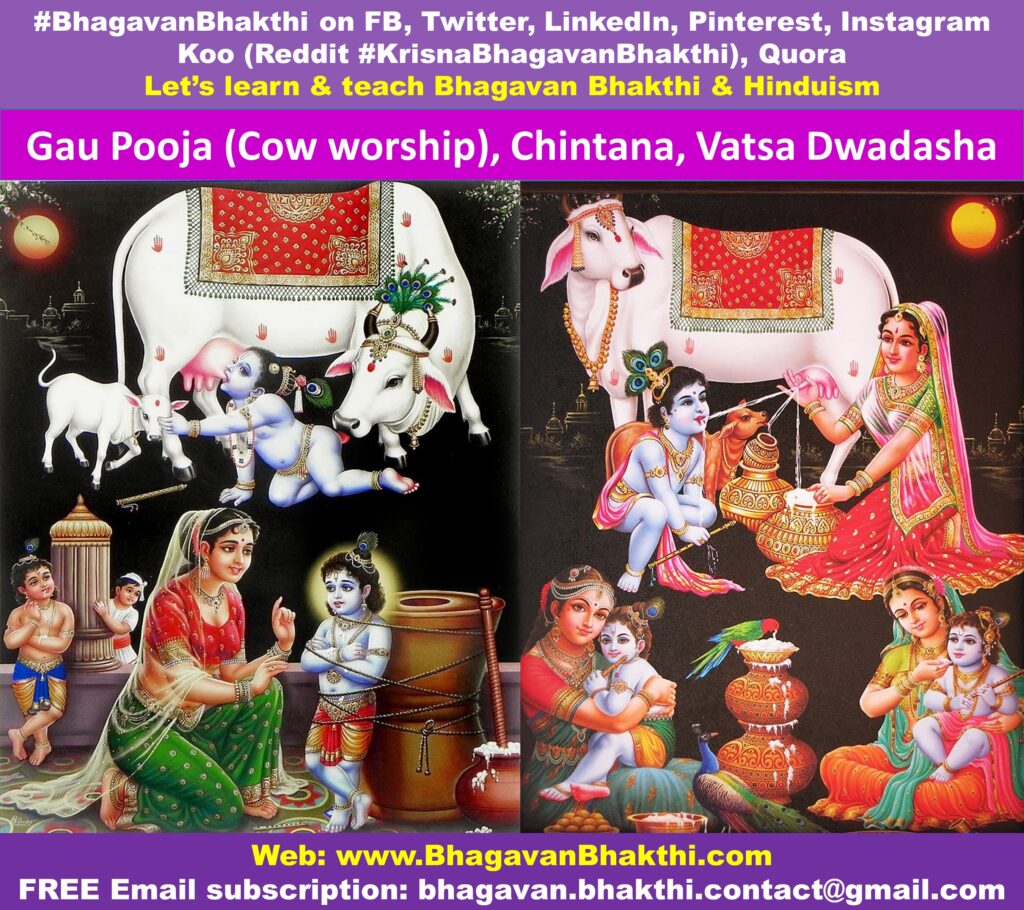
2. Nandini (नंदिनि / ನಂದಿನಿ / nandini): Nanda means someone who always give bliss, joy, jubilation, delight, happiness, rejoice, etc.
We must all know in Sanskrit ‘Ananda / आनंद / ಆನಂದ / ānanda means, he is the someone who will always be in bliss, happiness, delight etc.
(Bhagavan Sri Vishnu’s one name is आनंद / ಆನಂದ / ānanda, as he is the one who will always be in आनंद / ಆನಂದ / ānanda and he is the one who always gives आनंद / ಆನಂದ / ānanda to all.)
(Bhagavan Sri Vishnu is also known as ‘परमांनद / ಪರಮಾನಂದ / paramānanda’, as he is the one who is always be in ultimate bliss. parama + ananda = ultimate + bliss).
Thus, Nandini = Nanda + ini = Bliss + giver. Nandini is someone who always give bliss to everyone.
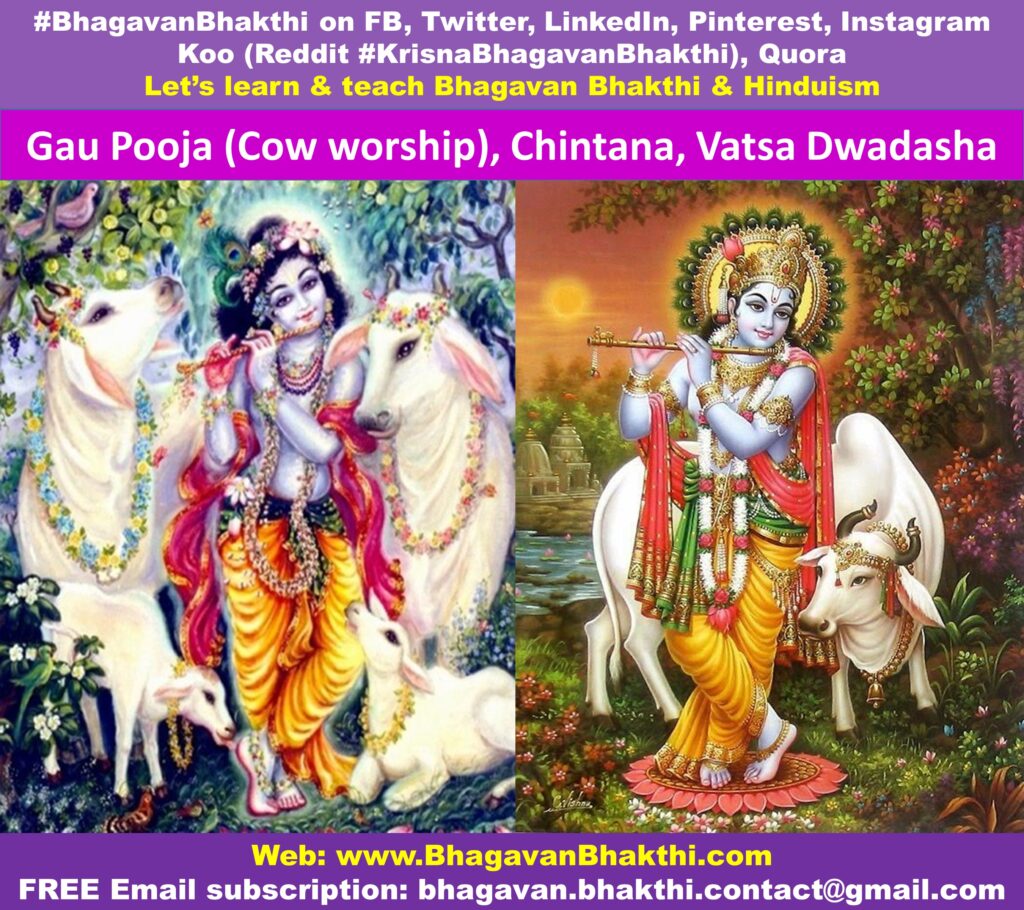
3. Surabhi (सुरभि / ಸುರಭಿ / surabhi): She is the one who is been donated / given by Devatas / Suras to Jamadagni Rishi. Surabhi = Sura + abhi = Devatas + Donated / given.
Also, Surabhi means she is the one who has fragrance, divine smell on her body. Similar, Surabhi means someone who has a golden body.
4. Susheela (सुशील / ಸುಶೀಲ / suśīla): She is the one who has high divine temperament. She is always a well conducted. She is on the one who has high moral.
She is the one who is having an amiable temper and other good qualities throughout her life. She is the one who is having very high moral and character. Susheela = su + sheela = Good / high + moral / character.
5. Bahula (बहुल / ಬಹುಲ / bahula): Here bahu + la = Abundant quantity + having / preserving / stored. She is the one who has different divine qualities in abundance.
Also, Bahula means, she is the one who stores divine milk in her body in abundance, so that she can donate it to others.
Now, let us move forward and let us know “How to do Gau pooja, chintana and other significance”:
Gau mata (Mother Cow) in Hinduism has a high symbol of righteousness (Satvika) since unknown time. By doing Gau pooja (aradhana) one will definitely develops the ‘Satvika’ characteristics.
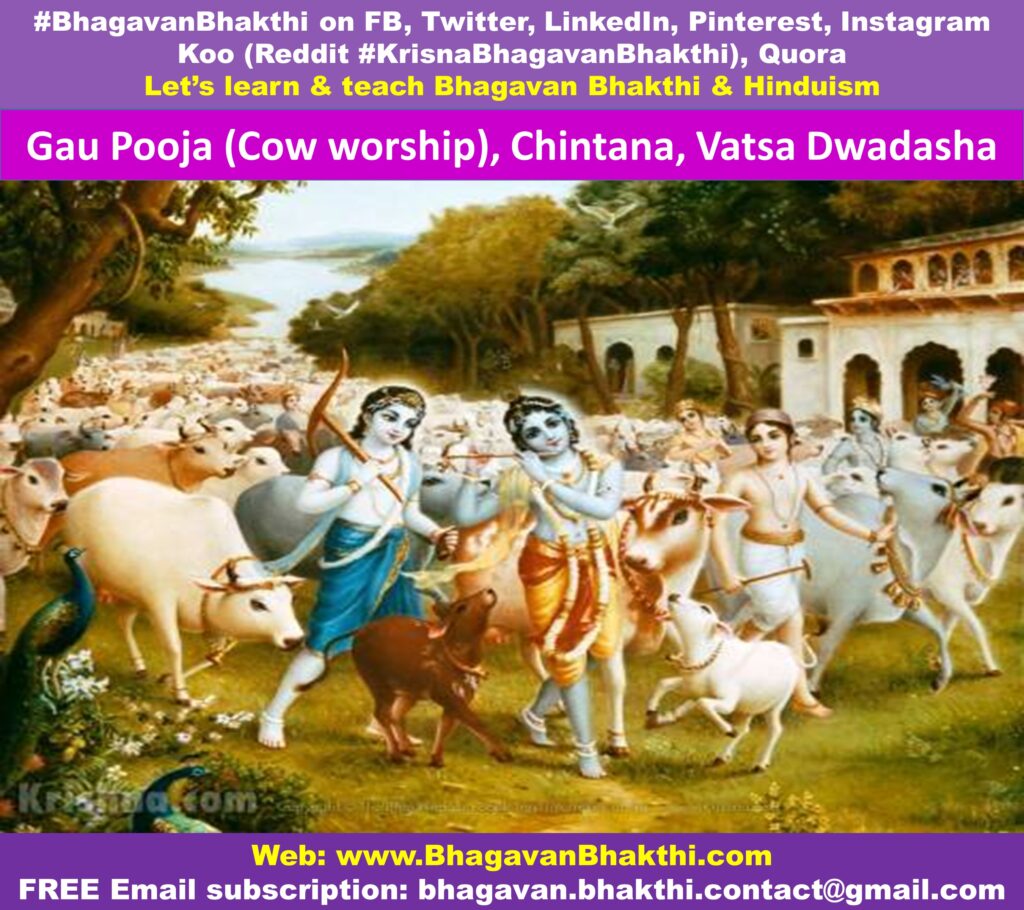
What does Gau pooja (aradhana) includes?
Gau Pooja (Divine worship) | Gau Seva (Divine serving) | Gau Poshana (Looking after like feeding etc.) | Gau Bhakti (Divine devotion) | Gau Rakshana etc. |
All the above mentioned are highly precious and dear to Bhagavan Sri Krishna / Vishnu.
Now, let us consider a shloka from the divine “Sri Vishnu Sahasranama Stotram”:
महेश्वासो महीभर्ता श्रीनिवासः सताङ्गतिः ।
अनिरुद्धः सुरानन्दो गोविंदो गोविदां पतिः ॥ 20 ॥
ಮಹೇಶ್ವಾಸೋ ಮಹೀಭರ್ತಾ ಶ್ರೀನಿವಾಸಃ ಸತಾಂಗತಿಃ ।
ಅನಿರುದ್ಧಃ ಸುರಾನಂದೋ ಗೋವಿಂದೋ ಗೋವಿದಾಂ ಪತಿಃ ॥ 20 ॥
mahēśvāsō mahībhartā śrīnivāsaḥ satāṅgatiḥ।
anirud’dhaḥ surānandō gōvindō gōvidāṁ patiḥ॥ 20॥
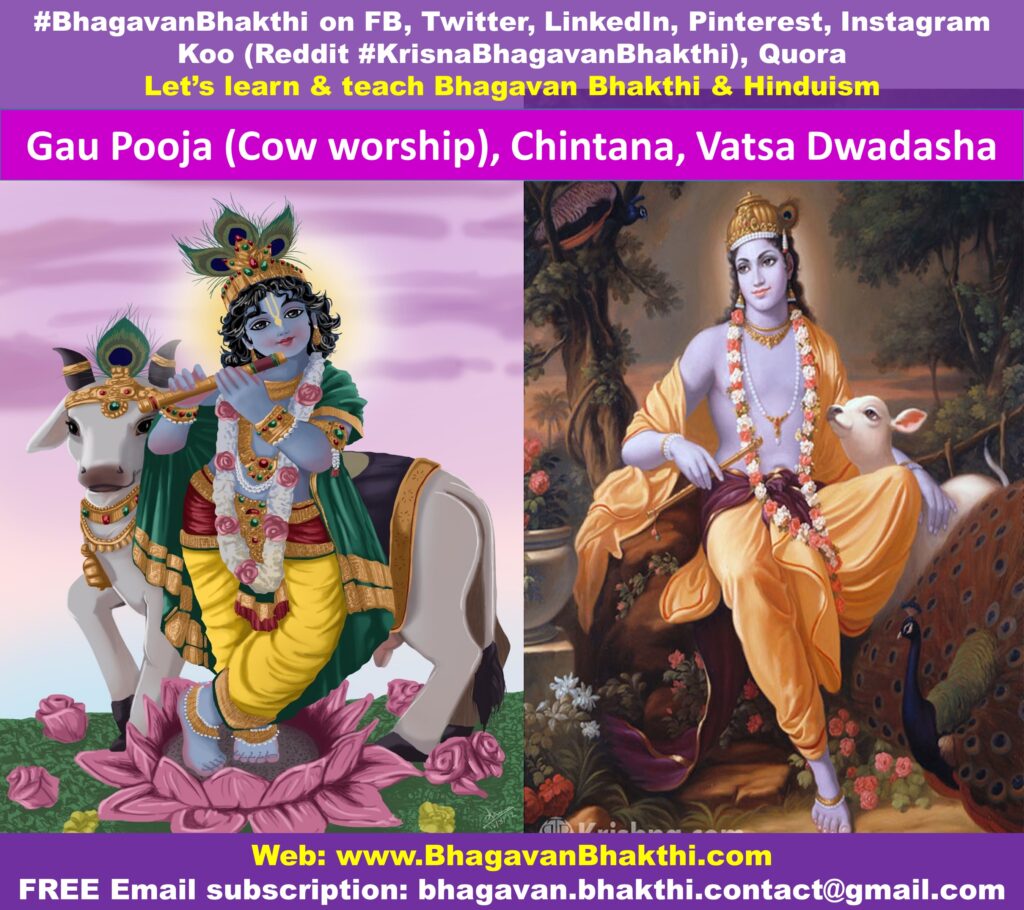
Meaning (Colored in pink): Govinda = He (Bhagavan Sri Krishna) is the one who has won over his all Indriyas and also he is the one who always protects Gau (Mother Cow), this means, Govinda is the protector of Gau (Mother Cow).
Govinda = Gov + in + da = Cow + Indriyas + Won. He (Bhagavan Sri Krishna) is the one who without hardship and with ease lifted the gigantic hill called Govardhana Giri (Hill) with His little finger to save and protect the Cows and Cowherds (Gopis and Gopikas).
Also He (Bhagavan Sri Krishna) is the one who is the protector of Earth. Only Bhagavan Sri Krishna is divinely known as Govinda and also he is known as Gopala (The protector of cows).
Let’s continue… Ashwayuja Bahula Dwadashi is reckoned as ‘GoVatsa Dwadashi’ and this day is dedicated in worshipping ‘Gau Mata’.
Here, Vatsa means very dear / offspring and Vatsala means very loving, highly kind, very affectionate. Whereas ‘Vatsalya’ means showing love, warmth etc.
Bhagavan Sri Krishna is called as ‘Gau Vatsala’ and he is the one who shows ‘Vatsalya’ (love, warmth) towards Gau mata (Mother Cow).
Let’s consider this divine shloka:
नमो ब्रह्मण्य देवाय गोब्राह्मण हिताय च ।
जगत् हिताय कृष्णाय गोविंदाय नमो नमः॥
ನಮೋ ಬ್ರಾಹ್ಮಣ್ಯ ದೇವಾಯ ಗೋಬ್ರಾಹ್ಮಣ ಹಿತಾಯ ಚ ।
ಜಗತ್ ಹಿತಾಯ ಕೃಷ್ಣಾಯ ಗೋವಿಂದಾಯ ನಮೋ ನಮಃ ।।
namō brāhmaṇya dēvāya gōbrāhmaṇa hitāya ca।
jagat hitāya kr̥ṣṇāya gōvindāya namō namaḥ।।
Meaning of the above sloka: My continuous and repeated namaste (Divine salutations) to the Bhagavan Sri Krishna, who is non other than the Para Brahma.
You (Bhagavan Sri Krishna) are the one who is the well-wisher of Cows and Brahmins. You (Bhagavan Sri Krishna) are the one who is the helper of the whole universe.
You (Bhagavan Sri Krishna) are the one who is Bhagavan Sri Krishna, who is also called with another name Govinda.
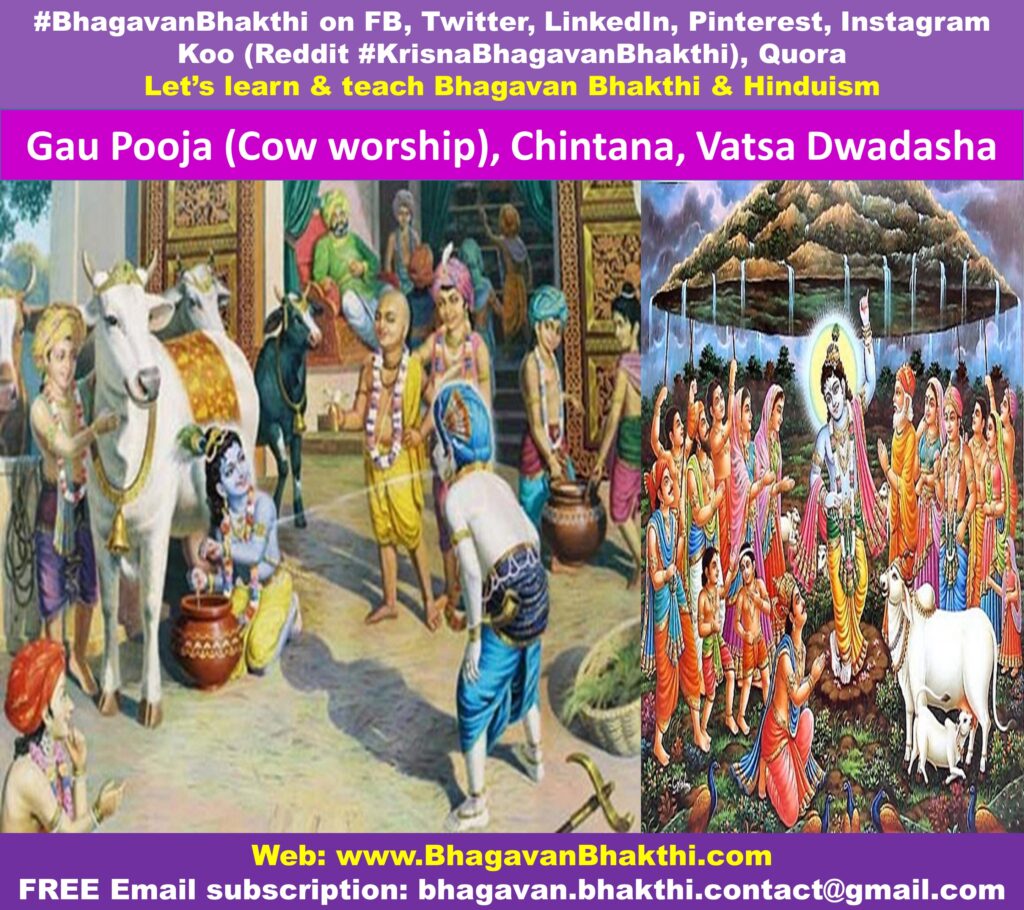
Let’s consider another divine shloka:
ಸರ್ವಕಾಮದುಧೇ ದೇವಿ ಸರ್ವತೀರ್ಥಾಭಿಷೇಚನಿ ।
ಪಾವನಿ ಸುರಭಿಶ್ರೇಷ್ಠೇ ದೇವೀ ತುಭ್ಯಂ ನಮೋಸ್ತು ತೇ ।।
सर्वकामदुधे देवी सर्वतीर्थाभिषेचनि ।
पावनि सुरभिश्रेष्ठे देवी तुभ्यं नमोऽस्तु ते ॥
sarvakāmadudhē dēvī sarvatīrthābhiṣēcani।
pāvani surabhiśrēṣṭhē dēvī tubhyaṁ namōstu tē ।।
Meaning of the above sloka: O Gau Mata, you are the one who full fill all the wishes of all and you are the one who give us the divine effects of bathing in all holy waters. O Gau Mata, you are the supreme holy Surabhi and thus please accept my namaste (Divine salutation).
Vedic culture (Sanatana Dharma) always instructs all to worship the Gau Mata (Mother Cow).
It is eternally believed that, all the Devatas / Demigods are present in the divine body of a sacred Gau Mata (Mother Cow) and is admired as a divine mata / mother in animal form.
Gau Mata, also called as Kamadhenu was emerged from the ‘Kshira Sagara’ at the time of churning. Gau Mata (Divine Cow or Dhenu) is considered as one of the Seven Mothers to be revered in the Vaidika Dharma.
To know about “What are the names of Sapta matrikas (Seven mothers), right meaning in Hinduism”, please visit this link: What are the names of Sapta matrikas (Seven mothers), right meaning in Hinduism
Now, let us consider the below divine shloka:
क्षीरोदार्णवसम्भूते सुरासुरनमस्कृते |
सर्वदेवमये मातर्गृहाणार्घ्य नमो नम: |
सर्वमये देवि सर्वदेवैरलड्कृते |
मातर्ममाभिलाषितं सफलं कुरु नन्दिनी |
In Hindu Sanatana Dharma, Gau Mata / Mother Cow is considered as divine and holy. Gau Mata / Mother Cow is a symbol of divine auspiciousness in Hindu Sanatana Dharm.
Bhagavan Sri Krishna says in Bhagavad-Gita (10.28):
आयुधानामहं वज्रं धेनूनामस्मि कामधुक् |
प्रजनश्चास्मि कन्दर्प: सर्पाणामस्मि वासुकि: || 10.28||
ಆಯುಧಾನಾಮಹಂ ವಜ್ರಂ ಧೇನೂನಾಮಸ್ಮಿ ಕಾಮಧುಕ್ |
ಪ್ರಜನಶ್ಚಾಸ್ಮಿ ಕಂದರ್ಪಃ ಸರ್ಪಾಣಾಮಸ್ಮಿ ವಾಸುಕಿಃ || 10.28 ||
āyudhānāmahaṁ vajraṁ dhēnūnāmasmi kāmadhuk |
prajanaścāsmi kandarpaḥ sarpāṇāmasmi vāsukiḥ || 10.28 ||
That is, He (Bhagavan Sri Krishna) is “Kaamadhenu‘ among the Cows – “dhēnūnāmasmi kāmadhuk”.
Now, let us know what Pancha Gavya (पांच गव्य / ಪಂಚ ಗವ್ಯ / pan̄ca gavya): There are totally five products which can be obtained and extracted from a Cow.
They are as given here: 1. Gomutra (cow urine) | 2. Gomaya (cow-dung) | 3. Goksheera (cow milk) | 4. Godadhi (cow-curd), and | 5. Goghruta (cow ghee). |
The mixture of all these five divine ingredients of Gau Mata / Mother Cow is known as Pancha Gavya (पांच गव्य / ಪಂಚ ಗವ್ಯ / pan̄ca gavya).
Since the ‘aadi kalam’ (Grand unknown time), Pancha Gavya (पांच गव्य / ಪಂಚ ಗವ್ಯ / pan̄ca gavya) is been used in all the ceremonies in Hindu Sanatana Dharma.
This Pancha Gavya (पांच गव्य / ಪಂಚ ಗವ್ಯ / pan̄ca gavya) is always divine and highly sacred and also provides the ‘adyatmika’ (Divinely spiritual) purification.
Even today, Pancha Gavya (पांच गव्य / ಪಂಚ ಗವ್ಯ / pan̄ca gavya) is used in Hindu families to purify self physical and mental body, as well as to sprinkle it all across the house after ‘ashoucha’ (Unhealthy, impure etc works).
In today’s modern times, multiple R & D is going on in Ayurvedic science on the healing properties of Pancha Gavya (पांच गव्य / ಪಂಚ ಗವ್ಯ / pan̄ca gavya), as it is a natural medicine for curing numerous diseases.
These Pancha Gavya (पांच गव्य / ಪಂಚ ಗವ್ಯ / pan̄ca gavya) ingredients are considered to have anti-bacterial, anti-septic, and anti-fungal properties.
These Pancha Gavya (पांच गव्य / ಪಂಚ ಗವ್ಯ / pan̄ca gavya) are used widely in production of Ayurvedic medicines.
Go-Padma Vrata : Go-Padma Vrata is one of the austerities advised for ‘Chaturmasya Vrata’ (Four months of Vrata).
This divine vrata is devoted in the worship of Gau Mata / Mother Cow during the four holy months of ‘Chaturmasa’ starting from ‘Ashada Shukla Ekadashi’ and ending on ‘Kartika Shukla Dwadashi’.
Go-Padma Vrata includes the following:
1. Worshiping of Gau Mata / Mother Cow | 2. Cleaning of पशुशाल / ಪಶೂಶಾಲ / paśuśāla (cattle sheds) | 3. Decorating with Rangolis (Kolam) | 4. Drawing a picture of Gau Mata / Mother Cow & Calf and |
5. Filling it up with 33 # Padmas drawn with Rangoli. | 6. Performing 33 # divine circumambulations (pradakshina) around the picture, | 7. Giving # 33 Arghya, Apoopa Daana etc. |
Go-padma vrata (vrat) story: Once upon a time, the divine beautiful dancer Rambha was dancing in Lord Indra Deva’s court. Music, dance and all most everything was going on perfectly and wonderfully in the Lord Indra Deva’s court.
But, suddenly a musical drum was cracked and broken, and thus the rhythm went wrong. Lord Indra Deva requested Lord Yama Deva (The god of Death), to get the musical drum reconstructed using the skin of a living being who never practiced a vrata / divine vow.
Thus, Lord Yama Deva and his men went in search of people who never practiced the vrata / vow in the correct way.
Lord Yama Deva and his men came back and told Lord Indra Deva – Ganga has a rangoli, Gauri has a rangoli, similarly Savitri, Draupadi, Anushya, Arundhati and Saraswati too have rangolis.
But for our surprise, there is no rangoli at Bhagavan Sri Krishna’s sister Subhadra’s house. Thus Lord Indra Deva ordered to bring back Subhadra, cut her skin and fit it to a drum.
After waking up in the morning, Bhagavan Sri Krishna went to Subhadra’s house and asked her “why she have you not drawn a rangoli in front of your house and not observing the vrata”.
Thus Subhadra replied, “I have brothers like Lord Indra Deva and Lord Chandra Deva, a husband like Arjuna, parents like Vasudeva and Devaki and of course you, Bhagavan Sri Krishna, then why should I draw rangoli in front of my house?”.
Bhagavan Sri Krishna his sister Subhadra Devi, that inspite of all these great relationship, she must always draw a rangoli in front of her house that have an eagle, the feet of Bhagavan Sri Vishnu, Sankha, Chakra, Mace, Lotus, Swastik,
Brindavana, Flute, Lute, Drum, Gau Mata (Mother Cow), calf and thirty-three (is it a numerical symbol for the thirty-three crore gods) lotus symbols, Rama’s cradle, Sita’s sari end, Tulasi leaf, Elephants and Guards.
This rangoli must and should be drawn outside cowsheds, similarly in near sacred rivers and ponds, also in front of God’s images and Tulasi brindavana.
Thus, Subhadra obtained hard rock from a hill and mixed it with pearls and corals and made powder of them and drew the rangoli.
Subhadra also offered turmeric, kumkuma and other offerings. Subhadra drew all rangolis due for five years in just one year.
Subhadra escaped the punishment of gods and they finally found an elephant calf that was sleeping with its head towards north. Lord Yama Deva’s soldiers took the skin from the back of the animal and made the drum.
Gau-Savitri Stotram: Gau-Savitri Stotram is taken from the great epic Mahabharata (Bhishma – Yudhishtira samvadam / discussion) – Stotram is given in three languages, that is, Sanskrit, Kannada and English.
|| अथ गोसावित्री स्तोत्रं ||
नारायणं नमस्कृत्य देविं त्रिभुवनेश्वरीम् |
गोसावित्रीं प्रवक्ष्यामि व्यासेनोक्तां सनातनीं || १ ||
यस्य श्रवण मात्रेण सर्वपापैः प्रमुच्यते |
गवां निश्वसितं वेदाः सषडंगपदक्रमाः || २ ||
शिक्षा व्याकरणं छंढो निरुक्तं ज्यौतिषं तथा |
एतासामग्र शृंगेषु इंद्रविष्णू स्वयंस्थितौ || ३ ||
शिरो ब्रह्मा गुरुः स्कंधे ललाटे वृषभध्वजः |
कर्णयोरश्विनौ देवौ चाक्षुषोः शशिभास्करौ || ४ ||
दांतेषु मरुतो देवा जिह्वायां च सरस्वती |
कंठे च वरुणो देवो हृदये हव्यवाहनः || ५ ||
उदरे पृथिवी देवी सशैलवनकानना |
ककुदि द्यौः सनक्षत्रा पृष्ठे वैवस्वतो यमः || ६ ||
ऊर्वोस्तु वसवो देवा वायुर्जंघे समाश्रितः |
आदित्यस्त्वाश्रितो वाले साध्याः सर्वांग संधिषु || ७ ||
अपाने सर्वतीर्थानि गोमूत्रे जाह्नवी स्वयम् |
धृतिः पुष्टिर्महालक्ष्मीर्गोमये संस्थिताः सदा || ८ ||
नासिकायां च श्रीदेवी ज्येष्ठा वसति भामिनी |
चत्वारः सागराः पूर्णा गवां ह्येव पयोधरे || ९ ||
खुरमद्येषु गंदर्वां खुराग्रे पन्नगाः श्रिताः |
खुराणां पश्चिमे भागे ह्यप्सराणां गणाः स्मृताः || १० ||
श्रोणी तटेषु पितरो रोमलांगूलमाश्रिताः |
ऋषयो रोमकूपेषु चर्मण्येव प्रजापतिः || ११ ||
हुंकारे चतुरो वेदा हुंशब्दे च प्रजापतिः |
एवं विष्णुमयं गात्रं तासां गोप्ता स केशवः || १२ ||
गवां दृ ष्ट्वा नमस्कृत्य कृत्वा चैव प्रदक्षिणम् |
प्रदक्षिणीकृता तेन सप्तद्वीप वसुंधरा || १३ ||
कामदोग्ध्री स्वयं कामदोग्धा सन्निहिता मम |
गोग्रासस्य विशेषो अस्ति हस्त संपूर्ण मात्रतः || १४ ||
शतब्राह्मण भुक्तेन सममाहर्युधिष्ठर |
य इदं पठते नित्यं श्रुणुयाद्वा समाहितः || १५ ||
ब्राह्मणो लभते विद्यां क्षत्रीयो राज्यमश्नुते |
वैश्यो धनसमृद्धः स्याच्छूद्रः पापात् प्रमुच्यते || १६ ||
गर्भीणी जनयेत पुत्रं कन्या भर्तारमाप्नुयात् |
सायं प्रातस्तु पठतां शांति स्वस्त्ययनं महत् || १७ ||
अहोरात्रकृतैः पापैस्तत्क्षणत् परिमुच्यते |
फलं तु गोसहस्रस्येत्युक्तं हि ब्रह्मणा पूरा || १८ ||
गावो मे ह्यग्रतः संतु गावो मे संतु पृष्ठतः |
गावो मे हृदये संतु गवां मध्ये वसाम्यूहम् || १९ ||
सुरभीर् वैष्णवी माता नित्यं विष्णुपते स्थिता |
गोग्रासं तु मया दत्तं सुरभिः प्रतिगृह्यताम् || २० ||
गावो मे मातरः सर्वाः सर्वे मे पितरो वृषाः |
ग्रासमुष्ठिं मया दत्तं सुरभिः प्रतिगृह्यताम् || २१ ||
फलानां गोसहस्रस्य प्रदद्याद्ब्राह्मणोत्तमे |
सर्वतीर्थाधिकं पुण्यमित्युक्तं ब्रह्मणा पूरा || २२ ||
|| इति गोसावित्री स्तोत्रं सम्पूर्णं ||
|| ಅಥ ಗೋಸಾವಿತ್ರೀ ಸ್ತೋತ್ರಂ ||
ನಾರಾಯಣಂ ನಮಸ್ಕೃತ್ಯ ದೇವೀಂ ತ್ರಿಭುವನೇಶ್ವರೀಮ್ |
ಗೋಸಾವಿತ್ರೀಂ ಪ್ರವಕ್ಷ್ಯಾಮಿ ವ್ಯಾಸೇನೋಕ್ತಾಂ ಸನಾತನೀಂ || ೧ ||
ಯಸ್ಯ ಶ್ರವಣ ಮಾತ್ರೇಣ ಸರ್ವಪಾಪೈಃ ಪ್ರಮುಚ್ಯತೇ |
ಗವಾಂ ನಿಶ್ವಸಿತಂ ವೇದಾಃ ಸಷಡಂಗಪದಕ್ರಮಾಃ || ೨ ||
ಶಿಕ್ಷಾ ವ್ಯಾಕರಣಂ ಛಂಧೋ ನಿರುಕ್ತಂ ಜ್ಯೌತಿಷಂ ತಥಾ |
ಏತಾಸಾಮಗ್ರಶೃಂಗೇಷು ಇಂದ್ರವಿಷ್ಣೂ ಸ್ವಯಂಸ್ಥಿತೌ || ೩ ||
ಶಿರೋ ಬ್ರಹ್ಮಾ ಗುರುಃ ಸ್ಕಂಧೇ ಲಲಾಟೇ ವೃಷಭಧ್ವಜಃ |
ಕರ್ಣಯೋರಶ್ವಿನೌ ದೇವೌ ಚಕ್ಷುಷೋಃ ಶಶಿಭಾಸ್ಕರೌ || ೪ ||
ದಂತೇಷು ಮರುತೋ ದೇವಾ ಜಿಹ್ವಾಯಾಂ ಚ ಸರಸ್ವತೀ |
ಕಂಠೇ ಚ ವರುಣೋ ದೇವೋ ಹೃದಯೇ ಹವ್ಯವಾಹನಃ || ೫ ||
ಉದರೇ ಪೃಥಿವೀ ದೇವೀ ಸಶೈಲವನಕಾನನಾ |
ಕಕುದಿ ದ್ಯೌಃ ಸನಕ್ಷತ್ರಾ ಪೃಷ್ಠೇ ವೈವಸ್ವತೋ ಯಮಃ || ೬ ||
ಊರ್ವೋಸ್ತು ವಸವೋ ದೇವಾ ವಾಯುರ್ಜಂಘೇ ಸಮಾಶ್ರಿತಃ |
ಆದಿತ್ಯಸ್ತ್ವಾಶ್ರಿತೋ ವಾಲೇ ಸಾಧ್ಯಾಃ ಸರ್ವಾಂಗಸಂಧಿಷು || ೭ ||
ಅಪಾನೇ ಸರ್ವತೀರ್ಥಾನಿ ಗೋಮುತ್ರೇ ಜಾಹ್ನವೀ ಸ್ವಯಮ್ |
ಧೃತಿಃ ಪುಷ್ಟಿರ್ಮಹಾಲಕ್ಷ್ಮೀರ್ಗೋಮಯೇ ಸಂಸ್ಥಿತಾಃ ಸದಾ || ೮ ||
ನಾಸಿಕಾಯಾಂ ಚ ಶ್ರೀದೇವೀ ಜ್ಯೇಷ್ಠಾ ವಸತಿ ಭಾಮಿನೀ |
ಚತ್ವಾರಃ ಸಾಗರಾಃ ಪೂರ್ಣಾ ಗವಾಂ ಹ್ಯೇವ ಪಯೋಧರೇ || ೯ ||
ಖುರಮಧ್ಯೇಷು ಗಂಧರ್ವಾಃ ಖುರಾಗ್ರೇ ಪನ್ನಗಾಃ ಶ್ರಿತಾಃ |
ಖುರಾಣಾಂ ಪಶ್ಚಿಮೇ ಭಾಗೇ ಹ್ಯಪ್ಸರಾಣಾಂ ಗಣಾಃ ಸ್ಮೃತಾಃ || ೧೦ ||
ಶ್ರೋಣೀತಟೇಷು ಪಿತರೋ ರೋಮಲಾಂಗೂಲಮಾಶ್ರಿತಾಃ |
ಋಷಯೋ ರೋಮಕೂಪೇಷು ಚರ್ಮಣ್ಯೇವ ಪ್ರಜಾಪತಿಃ || ೧೧ ||
ಹುಂಕಾರೇ ಚತುರೋ ವೇದಾ ಹುಂಶಬ್ದೇ ಚ ಪ್ರಜಾಪತಿಃ |
ಏವಂ ವೀಷ್ಣುಮಯಂ ಗಾತ್ರಂ ತಾಸಾಂ ಗೋಪ್ತಾ ಸ ಕೇಶವಃ || ೧೨ ||
ಗವಾಂ ದೃಷ್ಟ್ವಾ ನಮಸ್ಕೃತ್ಯ ಕೃತ್ವಾ ಚೈವ ಪ್ರದಕ್ಷಿಣಮ್ |
ಪ್ರದಕ್ಷಿಣೀಕೃತಾ ತೇನ ಸಪ್ತದ್ವೀಪಾ ವಸುಂಧರಾ || ೧೩ ||
ಕಾಮದೋಗ್ಧ್ರೀ ಸ್ವಯಂ ಕಾಮದೋಗ್ಧಾ ಸನ್ನಿಹಿತಾ ಮಮ |
ಗೋಗ್ರಾಸಸ್ಯ ವಿಶೇಷೋ ಅಸ್ತಿ ಹಸ್ತಸಂಪೂರ್ಣ ಮಾತ್ರತಃ || ೧೪ ||
ಶತಬ್ರಾಹ್ಮಣ ಭುಕ್ತೇನ ಸಮಮಾಹುರ್ಯುಧಿಷ್ಠರ |
ಯ ಇದಂ ಪಠತೇ ನಿತ್ಯಂ ಶೃಣುಯಾದ್ವಾ ಸಮಾಹಿತಃ || ೧೫ ||
ಬ್ರಾಹ್ಮಣೋ ಲಭತೇ ವಿದ್ಯಾಂ ಕ್ಷತ್ರೀಯೋ ರಾಜ್ಯಮಶ್ನುತೇ |
ವೈಶ್ಯೋ ಧನಸಮೃದ್ಧಃ ಸ್ಯಾಚ್ಛೂದ್ರಃ ಪಾಪಾತ್ ಪ್ರಮುಚ್ಯತೇ || ೧೬ ||
ಗರ್ಭೀಣೀ ಜನಯೇತ್ ಪುತ್ರಂ ಕನ್ಯಾ ಭರ್ತಾರಮಾಪ್ನುಯಾತ್ |
ಸಾಯಂ ಪ್ರಾತಸ್ತು ಪಠತಾಂ ಶಾಂತಿಸ್ವಸ್ತ್ಯಯನಂ ಮಹತ್ || ೧೭ ||
ಅಹೋರಾತ್ರಕೃತೈಃ ಪಾಪೈಸ್ತತ್ಕ್ಷಣಾತ್ ಪರಿಮುಚ್ಯತೇ |
ಫಲಂ ತು ಗೋಸಹಸ್ರಸ್ಯೇತ್ಯುಕ್ತಂ ಹಿ ಬ್ರಹ್ಮಣಾ ಪುರಾ || ೧೮ ||
ಗಾವೋ ಮೇ ಹ್ಯಗ್ರತಃ ಸಂತು ಗಾವೋ ಮೇ ಸಂತು ಪೃಷ್ಠತಃ |
ಗಾವೋ ಮೇ ಹೃದಯೇ ಸಂತು ಗವಾಂ ಮಧ್ಯೇ ವಸಾಮ್ಯಹಮ್ || ೧೯ ||
ಸುರಭಿರ್ವೈಷ್ಣವೀ ಮಾತಾ ನಿತ್ಯಂ ವಿಷ್ಣುಪದೇ ಸ್ಥಿತಾ |
ಗೋಗ್ರಾಸಂ ತು ಮಯಾ ದತ್ತಂ ಸುರಭಿಃ ಪ್ರತಿಗೃಹ್ಯತಾಮ್ || ೨೦ ||
ಗಾವೋ ಮೇ ಮಾತರಃ ಸರ್ವಾಃ ಸರ್ವೇ ಮೇ ಪಿತರೋ ವೃಷಾಃ |
ಗ್ರಾಸಮುಷ್ಠಿಂ ಮಯಾ ದತ್ತಂ ಸುರಭಿಃ ಪ್ರತಿಗೃಹ್ಯತಾಮ್ || ೨೧ ||
ಫಲಾನಾಂ ಗೋಸಹಸ್ರಸ್ಯ ಪ್ರದದ್ಯಾದ್ಬ್ರಾಹ್ಮಣೋತ್ತಮೇ |
ಸರ್ವತೀರ್ಥಾಧಿಕಂ ಪುಣ್ಯಮಿತ್ಯುಕ್ತಂ ಬ್ರಹ್ಮಣಾ ಪುರಾ || ೨೨ ||
|| ಇತಿ ಗೋಸಾವಿತ್ರೀ ಸ್ತೋತ್ರಂ ಸಂಪೂರ್ಣಂ ||
|| atha gōsāvitrī stōtraṁ ||
nārāyaṇaṁ namaskr̥tya dēvīṁ tribhuvanēśvarīm |
gōsāvitrīṁ pravakṣyāmi vyāsēnōktāṁ sanātanīṁ || 1 ||
yasya śravaṇa mātrēṇa sarvapāpaiḥ pramucyatē |
gavāṁ niśvasitaṁ vēdāḥ saṣaḍaṅgapadakramāḥ || 2 ||
śikṣā vyākaraṇaṁ chandhō niruktaṁ jyautiṣaṁ tathā |
ētāsāmagraśr̥ṅgēṣu indraviṣṇū svayansthitau || 3 ||
śirō brahmā guruḥ skandhē lalāṭē vr̥ṣabhadhvajaḥ |
karṇayōraśvinau dēvau cakṣuṣōḥ śaśibhāskarau || 4 ||
dantēṣu marutō dēvā jihvāyāṁ ca sarasvatī |
kaṇṭhē ca varuṇō dēvō hr̥dayē havyavāhanaḥ || 5 ||
udarē pr̥thivī dēvī saśailavanakānanā |
kakudi dyauḥ sanakṣatrā pr̥ṣṭhē vaivasvatō yamaḥ || 6 ||
ūrvōstu vasavō dēvā vāyurjaṅghē samāśritaḥ |
ādityastvāśritō vālē sādhyāḥ sarvāṅgasandhiṣu || 7 ||
apānē sarvatīrthāni gōmutrē jāhnavī svayam |
dhr̥tiḥ puṣṭirmahālakṣmīrgōmayē sansthitāḥ sadā || 8 ||
nāsikāyāṁ ca śrīdēvī jyēṣṭhā vasati bhāminī |
catvāraḥ sāgarāḥ pūrṇā gavāṁ hyēva payōdharē || 9 ||
khuramadhyēṣu gandharvāḥ khurāgrē pannagāḥ śritāḥ |
khurāṇāṁ paścimē bhāgē hyapsarāṇāṁ gaṇāḥ smr̥tāḥ || 10 ||
śrōṇītaṭēṣu pitarō rōmalāṅgūlamāśritāḥ |
r̥ṣayō rōmakūpēṣu carmaṇyēva prajāpatiḥ || 11 ||
huṅkārē caturō vēdā hunśabdē ca prajāpatiḥ |
ēvaṁ vīṣṇumayaṁ gātraṁ tāsāṁ gōptā sa kēśavaḥ || 12 ||
gavāṁ dr̥ṣṭvā namaskr̥tya kr̥tvā caiva pradakṣiṇam |
pradakṣiṇīkr̥tā tēna saptadvīpā vasundharā || 13 ||
kāmadōgdhrī svayaṁ kāmadōgdhā sannihitā mama |
gōgrāsasya viśēṣō asti hastasampūrṇa mātrataḥ || 14 ||
śatabrāhmaṇa bhuktēna samamāhuryudhiṣṭhara |
ya idaṁ paṭhatē nityaṁ śr̥ṇuyādvā samāhitaḥ || 15 ||
brāhmaṇō labhatē vidyāṁ kṣatrīyō rājyamaśnutē |
vaiśyō dhanasamr̥d’dhaḥ syācchūdraḥ pāpāt pramucyatē || 16 ||
garbhīṇī janayēt putraṁ kan’yā bhartāramāpnuyāt |
sāyaṁ prātastu paṭhatāṁ śāntisvastyayanaṁ mahat || 17 ||
ahōrātrakr̥taiḥ pāpaistatkṣaṇāt parimucyatē |
phalaṁ tu gōsahasrasyētyuktaṁ hi brahmaṇā purā || 18 ||
gāvō mē hyagrataḥ santu gāvō mē santu pr̥ṣṭhataḥ |
gāvō mē hr̥dayē santu gavāṁ madhyē vasāmyaham || 19 ||
surabhirvaiṣṇavī mātā nityaṁ viṣṇupadē sthitā |
gōgrāsaṁ tu mayā dattaṁ surabhiḥ pratigr̥hyatām || 20 ||
gāvō mē mātaraḥ sarvāḥ sarvē mē pitarō vr̥ṣāḥ |
grāsamuṣṭhiṁ mayā dattaṁ surabhiḥ pratigr̥hyatām || 21 ||
phalānāṁ gōsahasrasya pradadyādbrāhmaṇōttamē |
sarvatīrthādhikaṁ puṇyamityuktaṁ brahmaṇā purā || 22 ||
|| iti gōsāvitrī stōtraṁ sampūrṇaṁ ||
More information will be added to this on regular basis, please visit after some time to know more information.
To know more about Gau Mata (Mother Cow), kindly visit this link: About Gau Mata (Mother Cow)
To know more about Bhagavan Sri Narasimha, please visit this link: Bhagavan Sri Narasimha posts on Bhagavan Bhakthi website
To know more about Bhagavan Sri Vishnu, plase visit this link: Bhagavan Sri Vishnu posts on Bhagavan Bhakthi website
To know more about Bhagavan Sri Krishna, please visit this link: Bhagavan Sri Krishna posts on Bhagavan Bhakthi website
To know more about Bhagavan Sri Rama, please visit this link: Bhagavan Sri Rama posts on Bhagavan Bhakthi website
Dear friends, if you need any clarifications about this post, kindly let me know, I will definitely try to answer all of them.
Also your one LIKE, one COMMENT, One Share, one SUBSCRIPTION is highly important.
This will help to know the quality of this content and also it will be helpful to know if any improvements is required for the content.
If you feel this content is useful to you and has helped you to improve your knowledge, kindly share this with your well-wishers.
Because “SHARING MEANS CARING”.
For receive FREE EMAIL SUBSCRIPTION about #BhagavanBhakthi, you can send an email to [email protected] from your email ID.
NAMASTE!
Sri Gurubhyo Namaha
Sri Venkateshaaya Namaha
Sri Krishnaarpanamastu
Share in Social Media